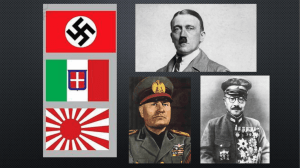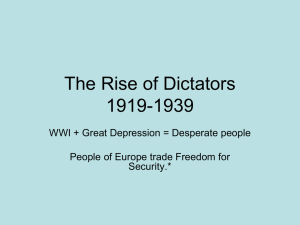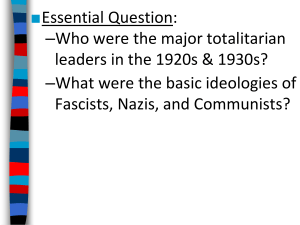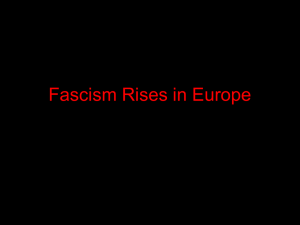File
advertisement
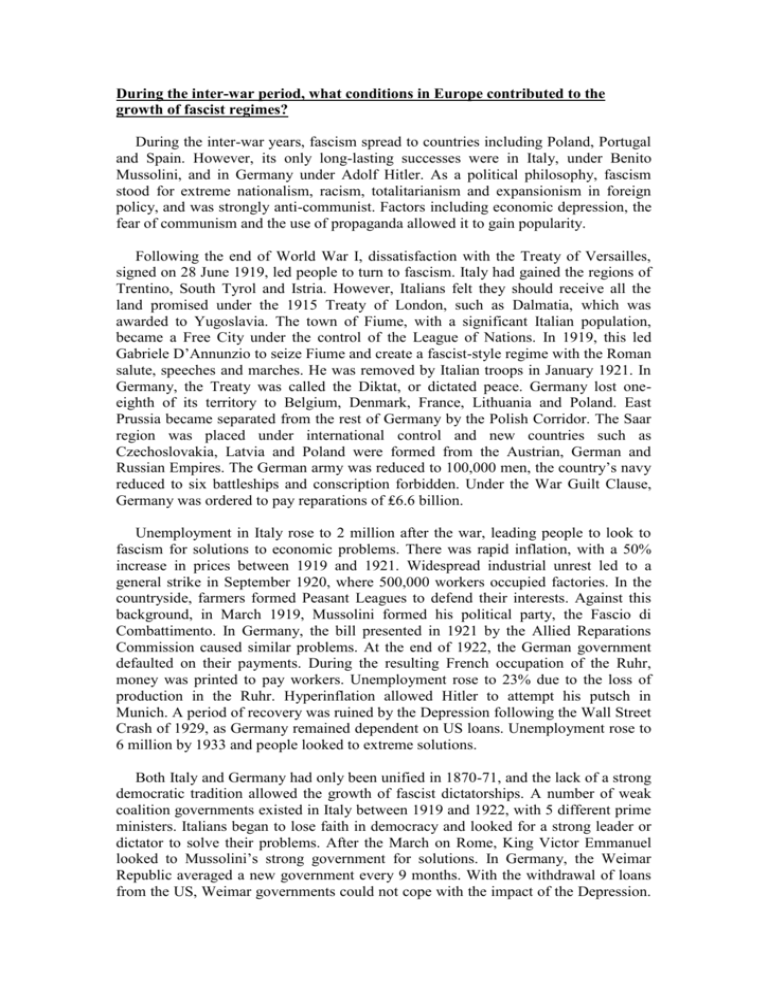
During the inter-war period, what conditions in Europe contributed to the growth of fascist regimes? During the inter-war years, fascism spread to countries including Poland, Portugal and Spain. However, its only long-lasting successes were in Italy, under Benito Mussolini, and in Germany under Adolf Hitler. As a political philosophy, fascism stood for extreme nationalism, racism, totalitarianism and expansionism in foreign policy, and was strongly anti-communist. Factors including economic depression, the fear of communism and the use of propaganda allowed it to gain popularity. Following the end of World War I, dissatisfaction with the Treaty of Versailles, signed on 28 June 1919, led people to turn to fascism. Italy had gained the regions of Trentino, South Tyrol and Istria. However, Italians felt they should receive all the land promised under the 1915 Treaty of London, such as Dalmatia, which was awarded to Yugoslavia. The town of Fiume, with a significant Italian population, became a Free City under the control of the League of Nations. In 1919, this led Gabriele D’Annunzio to seize Fiume and create a fascist-style regime with the Roman salute, speeches and marches. He was removed by Italian troops in January 1921. In Germany, the Treaty was called the Diktat, or dictated peace. Germany lost oneeighth of its territory to Belgium, Denmark, France, Lithuania and Poland. East Prussia became separated from the rest of Germany by the Polish Corridor. The Saar region was placed under international control and new countries such as Czechoslovakia, Latvia and Poland were formed from the Austrian, German and Russian Empires. The German army was reduced to 100,000 men, the country’s navy reduced to six battleships and conscription forbidden. Under the War Guilt Clause, Germany was ordered to pay reparations of ₤6.6 billion. Unemployment in Italy rose to 2 million after the war, leading people to look to fascism for solutions to economic problems. There was rapid inflation, with a 50% increase in prices between 1919 and 1921. Widespread industrial unrest led to a general strike in September 1920, where 500,000 workers occupied factories. In the countryside, farmers formed Peasant Leagues to defend their interests. Against this background, in March 1919, Mussolini formed his political party, the Fascio di Combattimento. In Germany, the bill presented in 1921 by the Allied Reparations Commission caused similar problems. At the end of 1922, the German government defaulted on their payments. During the resulting French occupation of the Ruhr, money was printed to pay workers. Unemployment rose to 23% due to the loss of production in the Ruhr. Hyperinflation allowed Hitler to attempt his putsch in Munich. A period of recovery was ruined by the Depression following the Wall Street Crash of 1929, as Germany remained dependent on US loans. Unemployment rose to 6 million by 1933 and people looked to extreme solutions. Both Italy and Germany had only been unified in 1870-71, and the lack of a strong democratic tradition allowed the growth of fascist dictatorships. A number of weak coalition governments existed in Italy between 1919 and 1922, with 5 different prime ministers. Italians began to lose faith in democracy and looked for a strong leader or dictator to solve their problems. After the March on Rome, King Victor Emmanuel looked to Mussolini’s strong government for solutions. In Germany, the Weimar Republic averaged a new government every 9 months. With the withdrawal of loans from the US, Weimar governments could not cope with the impact of the Depression. They were forced to rule by decree to introduce unpopular measures. The chancellor, Heinrich Brüning, became known as the “hunger chancellor,” as he lost the support of citizens. His reliance on Article 48, which gave the president emergency powers to pass laws, endangered democracy. As conditions in Italy began to resemble those that had existed in Russia in 1917, the fear of communism led Italians to support fascist leaders. Workers’ councils formed in some factories were similar to the soviets set up in Lenin’s Russia. The period of industrial unrest between 1919-21 became known as the Two Red Years. In Germany, the Communist Spartacus League, led by Karl Liebknecht and Rose Luxemburg, began a revolt in January 1919. Although the army and the Freikorps defeated the revolutionaries, fear of a communist takeover grew. In May, another Communist revolt in Bavaria was defeated. However, the Communist Party continued to seek a Soviet republic similar to the USSR under Lenin and Stalin. In both countries, fascist leaders such as Mussolini and Hitler were seen as protectors from the spread of communism. The ability of charismatic leaders such as Hitler and Mussolini to exploit nationalist sentiment played a crucial role. Mussolini attracted support by promising a return to old Roman glories. Similarly, Hitler spoke of the “Third Reich” and a return to former glories such as the Bismarck era. Mussolini’s use of the Blackshirts, the straight arm salute, marches and parades showed strength. Both were also outstanding speakers. The use of violence and propaganda by fascist parties also helped them to gain power. Unemployed soldiers were recruited into combat groups such as the Squadristi in Italy and the SA in Germany. In Italy left-wing party and newspaper officers were attacked and burned. Roughly 2000 people were victims of political violence between 1919 and 1922. The police and army, sympathetic to Mussolini, often turned a blind eye to fascist violence. Hitler’s attempt at violent revolution was largely halted by the Beer Hall Putsch of 8 November 1923, in which 16 Nazis were killed. Both made excellent use of propaganda, Mussolini giving himself the title “Il Duce” and Hitler “Der Führer.” In Germany, the greeting “Heil Hitler” was made compulsory for all party members, adding to the cult of personality surrounding Hitler. Nazi propaganda was aided by figures such as Joseph Goebbels, who became Hitler’s Minister for Popular Enlightenment and Propaganda, and later the director Leni Riefenstahl. Both leaders were elected democratically, Mussolini after he planned the March on Rome and Hitler with the aid of right-wing plotting, and both used the power of the state to create fascist totalitarian regimes. In November 1923, the Acerbo Law was passed in Italy, giving the party with the greatest number of votes in a general election two thirds of the seats in parliament. The April 1924 election saw Mussolini’s party receive 65% of votes. Following the murder of Matteoti, the remaining non-fascist MPs resigned from parliament in the Aventine Secession, increasing Mussolini’s power. A law passed on Christmas Eve 1925 stated that only the king could dismiss Mussolini. In November 1926, after an attempt on Mussolini’s life, all non-fascist parties were banned. The Fascist Grand Council replaced the parliament, bringing an end to democracy. Hitler’s Decree of the President for the Protection of People and State, passed following the Reichstag fire, formed the basis of police power in Germany. The Enabling Act, which followed the 1933 election, allowed the government to pass laws without the approval of parliament or president. The Communist Party were banned on 7 March 1933 and the Social Democrats on 21 June 1933, while other parties dissolved themselves. The death of President Hindenburg in August 1934 allowed Hitler to combine the offices of President and chancellor. Hitler and Mussolini’s expansionism contributed to the growth of fascism in Europe. Mussolini used wars in Libya and Abyssinia to gain new territory. Hitler’s introduction of conscription and remilitarisation of the Rhineland gave military power to fascism. The Anschluss with Austria also aided the growth of Hitler’s regime. Hitler’s taking of control in the Sudetenland and eventually the rest of Czechoslovakia in March 1939 also allowed fascist ideas to spread. However, with the invasion of Poland Hitler’s expansionism led to the Second World War, which would ultimately destroy fascism. Economic and political turmoil following World War I undoubtedly played a major role in bringing fascist leaders to power. These problems, along with the ability of Hitler and Mussolini to exploit such circumstances for their own gain, allowed fascism to grow rapidly in Europe until its defeat in 1945.




